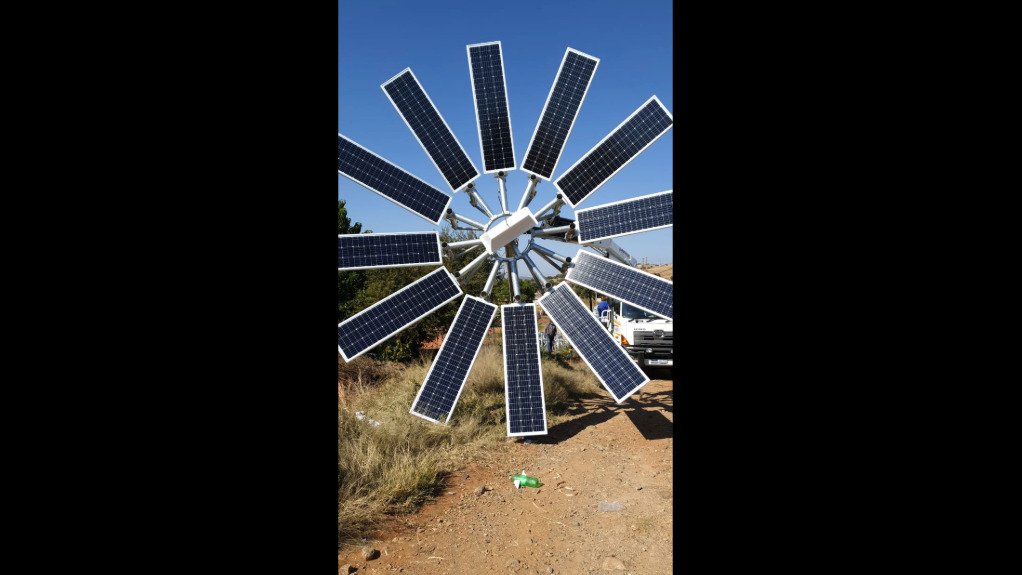Solar energy and lighting solutions provider ZRW Mechanika has successfully combined LED technology with renewable solar power to create its portable solar systems to provide lighting for informal and rural settlements and develop integrated solar high-mast solutions for area lighting.
LEDs have become the standard, as LEDs use less power, compared with fluorescent tubes, induction lights and incandescent lights, says ZRW Mechanika MD Dr Kamalluddien Parker.
Coupling LED lighting with solar power as a source of energy to store in batteries enables users to get sustainable hours of use in the night from the power produced by the solar panel in the day, he adds.
Consequently, ZRW Mechanika successfully combined its LED lighting solutions with solar power to create its “SIYAKHANYISA” portable solar systems, which means “Let there be ‘light!” in Xhosa.
The solar lighting kits include a 30 W amorphous durable solar panel, a pulse width modulation (PWM) solar charge controller, and four to six waterproof LED lights for use inside and outside.
It also offers radio power and features a USB port to charge smartphones or personal computers from a 6 V and 12 V DC source. The kits include switches, cabling and light fittings for the LED bulbs.
Parker adds that the solar panels are “tough” with rubber shells to protect against breakage and incorporate concealed brackets for mounting safely.
Once fully charged, the system will provide up to 12 hours of light, with an additional three days’ worth of backup power, should there be cloudy weather.
ZRW Mechanika started the design, development and prototyping for the solution in 2011, and has worked with an international partner, deploying “over thousands” of these kits in Southern Africa including application in Category C housing, such as informal housing areas, rural electrification, and more.
“With the deployment of this solution in local municipalities ZRW Mechanika has created thousands of community and youth jobs and opportunities, including by providing training for small-scale installers of these solutions,” Parker states.
He adds that the installations have been successful in providing less developed areas with access to basic lighting, enabling the ability to access power to charge phones, which, in turn, enables access to health, safety and policing services.
The solution has, therefore, allowed for improvements in quality of life and has helped reduce the use of toxic and flammable fuel, consequently reducing the risk of fire.
Another major innovation in design and application of solar power with LED technology is the ZRW solar integrated lighting solutions used in streetlighting and high-mast applications.
This solution provides area lighting as an alternative to conventional high masts, which use grid power with high-pressure sodium or mercury vapour lights.
Parker boasts that by using ZRW’s innovative design, the solar integrated light masts offer “a clean, sustainable, functional high-mast lighting” to help increase areas’ safety and security, without needing to rely on grid power or cabling.
Additionally, the solution is less prone to cable theft and can be installed 90% faster than conventional high masts.
Parker feels that this solution should become the standard for the installation of high-mast lighting in high-risk or high-density settlements, in particular, because it can support faster service delivery, in a sustainable way.
He notes that it can stimulate local engineering activity in steel and electrical sectors, while significantly reducing the impact of cable theft and damage.
Further, he notes that the solar high masts are also coupled with other surveillance and monitoring technologies such as weather stations, and cameras to make cities smarter and more sustainable.
According to ZRW, there are now many other products in the market. As the costs of solar system components have decreased over time, increasing numbers of “cheaper” and lower-quality solar products have entered the local market.
Parker commented that unfortunately, those that are less informed will fall for these inferior products that “on paper appear to be the same thing for a cheaper price”.
He told Engineering News, “one of the things you must understand is that our solar high masts have enhanced safety and security in general because where there is light, there is an increased sense of safety [owing] to visibility and early warning detection”.
He adds that in South Africa, there are major challenges pertaining to areas with unlit streetlights that result from the theft or vandalism of cables, luminaires and the metal casings of light bulbs.
He adds that this is an opportunity to significantly reduce these challenges while improving living conditions and creating jobs and new enterprises. It is also a solution that can be exported to other African States.
Parker says that these innovative solutions can form part of a broader plan for smarter and more sustainable cities that “promote local skills, local jobs, local engineering innovation”, concluding that “hopefully, these solar solutions can be deployed en masse to improve the living and environmental conditions of our citizenry”.
Edited by: Nadine James
Features Deputy Editor
EMAIL THIS ARTICLE SAVE THIS ARTICLE
ARTICLE ENQUIRY
To subscribe email subscriptions@creamermedia.co.za or click here
To advertise email advertising@creamermedia.co.za or click here













